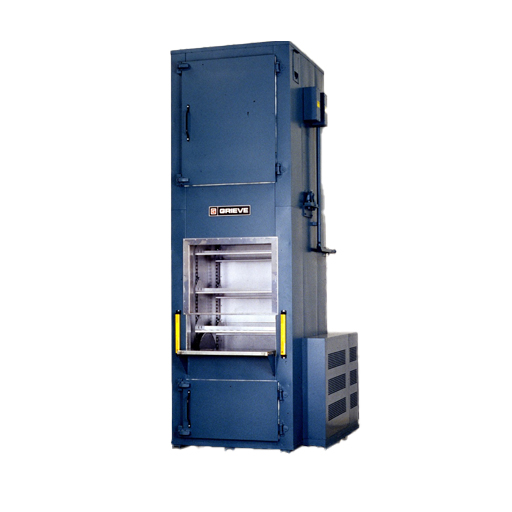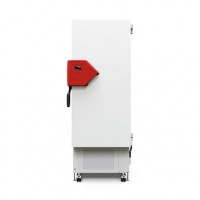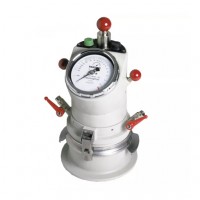Vertical Conveyor Ovens
- Grieve - Vertical Convoyer
- Motor control push buttons and on-off heat switch
- LED pilot lights
- 5 kA short circuit current rating (SCCR)
Vertical Conveyor Ovens are designed to minimize use of factory floor space.
They utilize vertically moving trays and are ideal for heating or curing parts within a work cell.
Heated parts are periodically removed from a tray and the tray filled with cold parts to pass through the oven. Trays can be indexed or move continuously. Our extensive experience working closely with our customers allows us to determine if a vertical conveyor is the correct solution for your heating process.
Certifications
- UL Listed Control Panel
- Meets the Requirements of the Following Standards:
- NFPA 86 (Standard for Ovens and Furnaces)
- NFPA 70 (National Electric Code)
- FM (Factory Mutual)
- OS
Caution
- Ovens processing combustible materials are required to have a fire suppression system per NFPA 86
- If flammable solvents or vapors are present in an oven, OSHA requires conformance with NFPA 86 Class A Oven requirements. A powered forced exhauster and other non-standard safety equipment must be added.
Safety Equipment
* Adjustable manual reset excess temperature interlock to turn off heat on malfunction of main temperature controller
* Recirculating blower air flow safety switch to turn off heat on loss of recirculated air flow
* Electrical interlock shuts off heat if power to recirculating blower is interrupted
Electric Heat Includes
- Separate heating element control contactors to turn off heat on malfunction of main control contactors
Gas heat includes
- Modulating burner for 1000 BTU per cubic foot natural gas at 6” water column pressure – propane available.
- Automatic pre-ignition purge period to clear accumulated gas or fumes
- Push button electric ignition
- Microprocessor based electronic flame safeguard protection to continuously monitor flame and close gas valves if flame is not present
- Powered forced exhauster to provide combustion venting
- Exhauster air flow safety switch to close gas valves on loss of venting
- Two pilot valves to guarantee gas flow to pilot can be stopped
- High and Low gas pressure switches to confirm safe operating pressure range
- Two main burner safety shut off valves with valve seat position indicator to assure gas flow to main burner can be stopped
- Proof of closure switch on one main valve to prevent igniting pilot unless main valve is closed
- Leak test station at each pilot and main burner valve to allow testing for leakage through valve.
Controls
- Digital temperature controller
- Motor control push buttons and on-off heat switch
- LED pilot lights
- 5 kA short circuit current rating (SCCR)
Construction
Available construction features:
Oven design can include:
- loading platforms outside oven
- staging area for parts to be heated
- trays passing outside oven for loading and unloading
- cooling zone to reduce part temperature before unloading
- vertical or horizontal recirculated air flow
- unheated vestibule to reduce heat loss from loading opening
- continuous or indexing drive
- index triggered by other machinery
- vertical lift doors tied to indexing
- window in loading door
- light curtains for operator safety
Trays can include:
- perforated surfaces to improve air flow across parts
- raised edges to retain parts
- fixtures on trays to position parts
- basket construction to replace trays
- removable tray inserts to be loaded and unloaded outside oven
- rollers for aid in moving heavy or bulky parts on and off trays
- dividers on trays to isolate individual parts
Choice of:
- Maximum operating temperatures up to 850°F
- Aluminized steel or stainless steel interior
- Vertical or horizontal recirculated air flow
- Electric or Gas heat
- 208 volt, 230 volt or 460 volt, 3-phase, 60 HZ – other input power available
Design can include:
- Loading platforms outside oven
- Staging area for parts to be heated
- Trays passing outside oven for loading and unloading
- Cooling zone to reduce part temperature before unloading
- Unheated vestibules to reduce heat loss from ends of oven
- Continuous or indexing belt drive
- Vertical lift doors tied to indexing
- Indexing triggered by other machinery
- Light curtains for operator safety
- Special tray or basket constructions dependent on part and loading requirements
- Removable tray inserts to be loaded and unloaded outside of oven
- All welded construction
- Structural steel base provides rigid assembly easily moved into position
- Heavy duty, welded structural steel conveyor slide bed supported by cross angles welded to vertical wall members to transfer belt load to factory floor
- Full coverage belt slide bed provides even belt wear
- Heavy duty reducer, torque limiting device and variable frequency conveyor drive
- Durable, electrically isolated, Incoloy tubular heating elements
- Heat source located in heat chamber to prevent radiant heating
- High pressure recirculating blower
- Full coverage supply and return duct work with adjustable opposed louvers
- Adjustable fresh air intake and exhaust outlet damper
- Insulated with 10 lbs per cubic foot density rockwool insulation
- Aluminized steel exterior with Trilite Green enamel finish
- Includes 2” refractory ceramic fiber insulation on 16 gauge aluminized steel interior walls, 16 gauge 304 stainless steel heat chamber walls and stainless steel recirculating blower
- Brushed stainless steel control panel face
- Heavy duty access doors along oven length with explosion venting latches
- Adjustable dampers at ends of heat zone positioned near load to reduce heat loss
- Slip flashing at doorways allow inner oven to expand without affecting door sealing
- Fiberglass door gasket with stainless steel spring insert
- Fully assembled and factory tested for temperature uniformity



Do you have a question?
min 10 ch